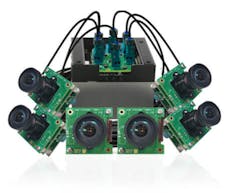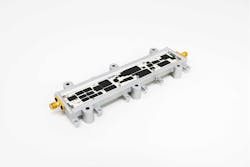Electronic warfare: all systems go
By Jim Romeo
Many new technologies, processes, and collaborations all are converging on electronic warfare (EW), providing reason to be optimistic and bullish about its future.
Jonathan Roberts is an engineer at the RAND Corporation in Santa Monica, Calif., whose research focuses on EW, radar, and low-observable technology.
"Since the Electromagnetic Spectrum Superiority Strategy was released in 2020 there has been a lot of work put into harmonizing capabilities between services and partner nations. In terms of general EW technology, cognitive EW is the future,“ Roberts says. “Cognitive EW is driving advances in data science and signal processing related to what we field and how we think about data that would have previously been discarded.”
Advancements in autonomy
The U.S. Senate calls for the U.S. Department of Defense (DOD) to address deficiencies in the electronic protection of defense systems. This "ensures that“It is no secret that our weaponry and defense systems are becoming increasingly autonomous," Bartur continues. "As a result, signal transport to manage these systems remotely will require higher frequencies that support more bandwidth and lower latency but also introduces higher attenuation and easier obstruction by natural environments and disruption from EMPs [electromagnetic pulse attacks]."
Bartur points to one signal processing trend that seeks to use RF over fiber for remote antennas as a way to protect electronic signals from detection and interference. This offers a fully analog transport for radio communication over light waves between antennas and the protected areas where sensitive equipment is located.
"Whether it is military radar, cellular and satellite communications, GPS, or GNSS, the fiber used in antenna remoting is completely resistant to electromagnetic interference," Bartur says. "This technique is also being used in sensitive compartmented information facilities to provide secure Wi-Fi."
This approach places placing all access points of the network in an impenetrable area, using fiber to connect to the antennas, and uses a multiple-input and multiple-output (MIMO) architecture for very low signal footprint.
Spectrum agility and data processing
Mike Lewis is the principal director and leader in Booz Allen’s global defense business. Lewis, along with many other industry professionals are quick to point out the value of electromagnetic spectrum dominance.
“Electromagnetic spectrum dominance is as important as air dominance in the past: vital and scale-tipping,” Lewis says. “Electromagnetic warfare impacts each stage of the existing observe, orient, decide, act loop in a consequential way. As we pivot to more capable potential foes, the impact grows exponentially. As these conflicts grow, such as Ukraine, the overall DOD focus and importance of EW becomes a cornerstone again."
Core capabilities involve the ability to sense, make-sense, reason, and effect with lethal and non-lethal effects. "Another aspect of EW desperately needed is the ability to understand, plan, manage, assess, command, and control joint electromagnetic spectrum operations (JEMSO)," Lewis says.
An important part of this is recognizing the coordination and collaboration necessary to avoid fratricide and use assets efficiently. "The ability to plan and orchestrate these across services and domains will need to continue to grow and improve," Lewis continues. The artificial intelligence (AI) capabilities to integrate and assist in the decision-making process will be an essential component to enable these cross-domain decisions."
Providing the right information to AI processing engines will play a big part. "It is imperative to ensure information sharing across domains, systems, and services," Lewis says. This sharing of information will be a key attribute of success as the DOD continues to improve and enhance the existing capability set. Unfortunately, today a significant amount of those EW capabilities is less connected and share less information that is optimal and needed in the future."
Still, there's reason to be hopeful. "I’m excited to see the DOD recognize these facts and work towards standards for communications and data sharing," Lewis says. "It is also imperative to continue to make updates and enhancements to fielded systems."
Members of the DOD, such as the Army, are taking steps toward future upgrades to fielded systems. "This will help existing systems stay current and optimized going forward," Lewis says. "Another trend that is key to drive adaptability going forward is the ability to rapidly reprogram our sensors and weapon systems. It is vital to quickly understand friend vs foe and react appropriately. The battlefield electromagnetic spectrum will be changing quickly, and our systems will need the ability to be forward-looking and learn using dynamic updating solutions along with AI tools.”
Ripe for advancement
Electromagnetic spectrum capabilities are building tremendous capability that is ripe for advancement. Lorne Graves is the chief technologist for RF Systems at RF and microwave specialist Spectrum Control in Fairview, Pa.
"To put it more bluntly, there is an initiative to accelerate the commercial use of the spectrum for growth in both government and commercial revenues while securing – and possibly enhancing – defense systems to mitigate and exploit the impact," Graves says.
In addition to electromagnetic spectrum capabilities, digital technologies, in general, are helping RF architectures that can be beneficial in many ways.
"Second-generation direct-digital technologies are starting to emerge in the marketplace and wideband are enough to merit the first major re-planning of RF architectures for new start programs,” Graves adds. “However, high technology readiness level (TRL) requirements for rapid takeoffs will make for some interesting mixing and matching of old digital and analog architectures with new digital capabilities. At these transitional moments, defense programs may need to take a little more risk to ensure they continue leading-edge technology innovation and not just fund re-engineering efforts of nearly the same capability but with more software."
This also points to a heightened emphasis on electromagnetic battle management. "One of the key initiatives in EW right now is an emphasis on electromagnetic battle management (EMBM)," says Josh Niedzwiecki, vice president and general manager of electronic combat solutions at BAE Systems in Nashua, N.H.
"Today, each platform has to defeat all of the threats they face. With effective EMBM, strike packages of disparate platforms will be able to collaborate to defeat the network they face," Niedzwiecki says. "Optimizing all signal processing and spectrum attack resources across the strike package and supporting assets gives teams a much broader arsenal of electromagnetic weapons. In addition, effective use of resources allows tactical data collections to learn from the environment and capability developers to create effective countermeasures and electronic attacks against emerging threat signals."
Chris Ciufo is the chief commercial officer and chief technology officer at General Micro Systems in Rancho Cucamonga, Calif. He says that an underlying problem with sophisticated EW is related to the ability to move and process data.
“Advanced electronic warfare and the receiving side ISR [intelligence, surveillance, reconnaissance] initiatives from labs haven’t percolated out to programs yet in a big way,” Ciufo says. “In fact, from a ‘sensor’ standpoint, the bottlenecks are more the ability to move the data, process the data, and interpret the results."
It wasn't always this way. "Moving the data once relied on proprietary pipes like FPDP (for sonar) or RACE++ for radar, but 1-gigabit-per-second Ethernet moved in. Now, we see that 10-gigabit-per-second Ethernet is the norm for moving data, with 100 gigabits per second being requested for near-term programs."
Value of data
Ciufo says that advancement in the use of sensors can boost the value of the underlying data that such sensors capture.
“Don’t ignore the simplest sensors, since new AI engines can interpolate or interpret data in new ways that bring to light information not previously ‘visible.’ Case inOthers are paying attention to communications networks, and the transference of commercial 5G to defense applications is important and influential to support modern weapon systems. Alexander Wyglinski is the Associate dean of graduate studies and a professor of electrical and computer engineering at Worcester Polytechnic Institute in Worcester, Mass.
“Given how DOD is employing private 5G networks in the field for various types of operations and missions, there exists a wide range of issues associated with commercial technologies being retrofitted for military applications,” Wyglinski says.
“Many of these issues revolve around the topic of spectrum dominance in challenged environments," he continues "In addition to spectrally co-existing with commercial 5G networks, various adversaries are developing techniques capable of disrupting DOD private 5G networks by exploiting different adaptive/intelligent mechanisms at different layers of the protocol stack, ranging from the radio frequency (RF) characteristics of the individual wireless devices to how these networks access the wireless medium all the way to how networks are formed to generate secure, robust topologies. As a result, there are numerous opportunities for R&D efforts to identify threats against DOD private 5G networks and generate new intelligent cost-effective mechanisms to counter-act these threats.”
Dave Harrold is the vice president and general manager of countermeasure and electromagnetic attack solutions at BAE Systems in Nashua, N.H. He notes the importance of RF and electro-optic/infrared capabilities.
"When platforms need to execute missions in highly contested battle spaces and they will definitely be detected, a full spectrum approach to EW that combines radio frequency electro-optic/infrared capabilities is necessary to counter adversaries’ kill chains, enable freedom of maneuver, and improve warfighters’ survivability and lethality," Harrold says.
"The layered full spectrum approach includes emerging technologies and capabilities, including next-generation countermeasure dispensers and air-launched effects," he continues. "The reason full-spectrum EW is so powerful is that different portions of the spectrum offer unique advantages. For instance, weather has much less effect on RF capabilities than EO/IR. EO/IR can offer greater precision and detect features not seen in RF. The first step is to integrate full spectrum capabilities on individual platforms, and then across platforms. Using EMBM, we can enable and coordinate heterogeneous platform capabilities across the physical domains to greatly enhance mission effectiveness."
Intelligence gathering
Neil Sampson is the director of aerospace and defense at semiconductor designer GSI Technology Inc. in Sunnyvale, Calif. Like others, Sampson sees improvements in capability of sensor inputs and intelligence gathering among the many things that remain a boon to EW capability.
"EW has always been a central tenet in advanced warfare,” Sampson says. “From listening in the oceans passively for signatures of hostile submarines to watching the skies for unidentified incursions. The modern battlefield utilizes a multitude of sensor inputs and intelligence gathering to guide actions and coordinate timing of attacks for greater effect. With faster processing, and newer methods such as AI and fusion processing, DOD has increased pressure to advance their processing platforms from traditional first principal DSP processing to inference driven assistance to the battlefield decision maker. The successful adopter(s) of this will increase the warfighter's ability to see all and make highly effective real-time decisions."
Sampson adds that DOD always has sought to advanced many new and useful technologies and has worked hard at their development and adoption. "Everyone is subject to the fallacy of making good better by doing it faster or with more powerful versions of the same processing,” Sampson says. “As we look at AI we can see similar processing in training and inference because the processor happens to be good at matrix multiplication. If we look at ourselves training and application are not done the same. This opens the path for technologies that may not be suitable for radiation environments, and low power edge applications to be used for training, but different technologies for actual fielding decision making."
There’s also some developments and advancements aiding the use of collaborative EW and cognitive EW. Mike Paturzo is the vice president of global sales and strategy for electronic systems at Textron Systems. "Key initiatives in Electronic Warfare (EW) include collaborative EW and cognitive EW," Paturzo says. “Collaborative EW focuses on using multiple cooperating EW platforms to achieve enhanced EW effects. Examples include passive listening from multiple platforms to achieve faster geolocation of the source of an emission and the use of multiple platforms to broaden the effectiveness of Electronic Attack (EA). Cognitive EW seeks to deploy Machine Learning and Artificial Intelligence to the problem of recognizing signals that may comprise an unknown threat and the deployment of countermeasures to defeat the threat."
It's clear that the operational importance of EW is increasing. "The world is an increasingly networked environment and the ability to exploit or deny the electromagnetic spectrum is increasingly important to operational success," Paturzo says. This fact was underscored by the successful Ukrainian attack on the Russian Cruiser Moskva, which was enabled by EW technology."
Paturzo also highlights trends in signal processing that include the availability of analog-to-digital converters (A/D converters) and digital-to-analog converters (D/A converters) with ever-increasing sample data rates, and the widespread availability of graphics processing units (GPUs) as key technologies that are assisting EW.
"The availability of faster Sample Data Rates has the effect of moving the D/A conversion closer to the antenna, which generally provides more capability, better accuracy, and reduced RF parasites," Paturzo says. "The widespread availability of GPUs allows much faster processing of complex algorithms, particularly those that involve large arrays of data."
Communications and sensors
As communications and sensors combine with advancements in space operations, there’s an emergent decision superiority for the DOD. Emil Kheyfets director of military and aerospace business development for Aitech Defense Systems Inc. in Chatsworth, Calif.
“Advances in telecommunications, sensors, processing power, and weapons, along with the growing utility of space and cyberspace as operational domains, have fundamentally shifted the character of command and control in warfare,” Kheyfets says. “With this in mind, the DOD is seeking to achieve decision superiority through [Joint All Domain Command and Control] JADC2 “to produce the warfighting capability to sense, make sense, and act at all levels and phases of war, across all domains, and with partners, to deliver information advantage at the speed of relevance."
Kheyfets says that achieving the JADC2 vision means connecting every current sensor that can support battlespace awareness, making sensor data available to any potential user, at any level of operation. Leveraging AI/ML and advanced algorithmic warfare systems will help in achieving this data-sharing construct.
Kheyfets adds that to make the JADC2 concept a reality, the military services must analyze what each contribution will be in achieving this vision. “While many services are focusing on creating a global targeting system that can enable the find, fix, track, target, engage, and assess functions of the kill chain, some are looking at how JADC2 can assist with achieving decision superiority to maneuver forces to positions of advantage to prevent an adversary from meeting their objectives,“ he says.
The road ahead
Overall, many are upbeat about improvements in EW systems. Bill Conley, chief technology officer Mercury Systems Inc. in Andover, Mass., is bullish on technology advancements that will influence EW.
"We remain excited about the continued need to upgrade and improve EW systems,” Conley says. “Since Russia’s invasion of Ukraine, we’ve seen how software updates to SATCOM systems could mitigate the Russian jammers. We’ve also seen an increasingly contested electromagnetic spectrum as drones are used to support targeting, and long-range precision strike weapons are employed. The U.S. Defense Department is investing to upgrade aircraft and maritime EW capabilities as a part of the current strategy and focus in the INDOPACOM region."
Simultaneously, Conley says that microelectronics has advanced substantially over the past several years. “The newest A/D converters, D/A converters, field-programmable gate arrays, and novel processors are being blended through chiplets to allow capable, and rapid, component technologies to be formed. Direct RF is a key trend that impacts numerous systems by enabling the development of flexible and compact signal processing solutions, bringing AI-level computer power to smaller platforms," he says. “Lastly, the analog front end remains critical to ensuring the finite dynamic range of these digital components can be optimized; broadband tunable filters, solid-state power amplifiers and apertures are critical to our future competitiveness."
Predicting the future can be tricky, yet "it seems likely there will continue be steady advancement in digital signal processing power, sampled data rates, and data memory capabilities," says Textron's Paturzo. "There will be continued emphasis on collaborative EW, with an expectation that significant advancements in capability will be obtained as a result. There will also be continued emphasis on cognitive EW, but here the likely outcome is that technical reality will eventually trump the unrealistic expectations. No doubt the hype will be maintained as long as it can be, but at some point, unless there is a significant new breakthrough, the impediments imposed by the technical reality are likely to block an advance to true autonomy."
When everything adds up, there's plenty of reason to be optimistic about advancements in EW and its effect on our defense capabilities. And there's more technological development to come in future years.
"The breakthroughs required for the laboratory and range test equipment will require additional level of complexity and even greater advancement in technology," Paturzo says. "Machine Learning (ML) and Artificial Intelligence (AI) have the potential to enhance this test community and may unburden human EW test operators."
Link to electronic warfare company list:
https://www.militaryaerospace.com/search?filters={"text":"electronic%20warfare","type":{"value":["Company"]},"websiteSchedule":{"value":[]},"page":1}



